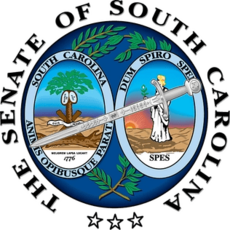South Carolina Senate facts for kids
Quick facts for kids South Carolina State Senate |
|
|---|---|
| South Carolina General Assembly | |

Seal of the South Carolina Senate
|
|
| Type | |
| Type | |
|
Term limits
|
None |
| History | |
|
New session started
|
January 9, 2024 |
| Leadership | |
|
President
|
Thomas Alexander (R)
Since December 6, 2021 |
|
Majority Leader
|
Shane Massey (R)
Since April 6, 2016 |
|
Minority Leader
|
Brad Hutto (D)
Since November 17, 2020 |
| Structure | |
| Seats | 46 |
 |
|
|
Political groups
|
Majority
Minority
|
|
Length of term
|
4 years |
| Authority | Article III, South Carolina Constitution |
| Salary | $10,400/year + per diem |
| Elections | |
|
Last election
|
November 5, 2024 (46 seats) |
|
Next election
|
November 7, 2028 (46 seats) |
| Redistricting | Legislative Control |
| Meeting place | |
 |
|
| State Senate Chamber South Carolina State House Columbia, South Carolina |
|
| Website | |
| South Carolina Senate | |
The South Carolina State Senate is an important part of the government in South Carolina. It is the "upper house" of the South Carolina General Assembly, which is the state's law-making group. The "lower house" is the South Carolina House of Representatives.
The Senate has 46 members called senators. Each senator is chosen from a different area, or "district," in the state. They serve for four years. Their elections happen at the same time as United States presidential elections.
Long ago, the South Carolina Constitution of 1895 said that each county would elect one senator. This changed after a big court decision in 1964 called Reynolds v. Sims. This ruling made sure that all voting districts had about the same number of people. This way, everyone's vote counts equally. Because of this, the Senate changed how its districts were set up several times. By 1984, South Carolina started using a system where each senator represents just one district.
The General Assembly, which includes the Senate, meets every year. They gather at the State Capitol Building in Columbia. Their meetings start on the second Tuesday of January. They can take a break for 30 days if most members agree. They can take a longer break if two-thirds of the members agree.
Who Makes Up the Senate?
The South Carolina State Senate has 46 members. Currently, most of the senators are from the Republican Party. There are 34 Republican senators. The other 12 senators are from the Democratic Party. This means the Republican Party has the majority, or more than half, of the seats.
Senators are elected to represent different parts of the state. Each senator works to make laws and decisions that help the people in their district and all of South Carolina.
See Also
- List of South Carolina state legislatures


